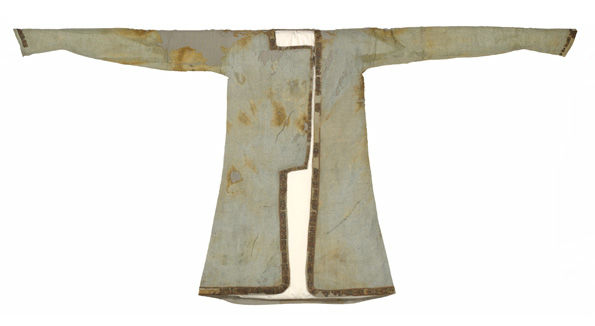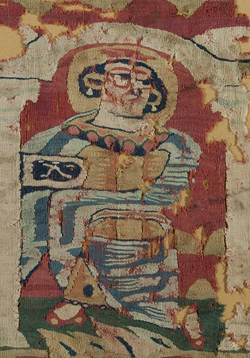While garment styles in the Late Antique world were simple in form—consisting of the T-shaped tunic for men and children, and loose, draped garments, such as the gunna and palla, for women—Persian garments of the late Sasanian period (220–650) reflect more complex tailoring and forms. Descended from the riding costume of the nomads from the Central Asian steppes, the outer garments for royalty and high-ranking men consisted of a round-necked, knee-length jacket tailored to fit the waist and upper body, and either tight trousers held in place by a strap passing under the foot or loose trousers tucked into boots. A round-necked, long-sleeved belted tunic was generally worn underneath the coat, as well as under a crossover-type jacket called the caftan. Depictions of these costume styles have been found on metal objects and rock reliefs in places such as the sixth- to seventh-century site Taq-e Bostan (Iran). (Evidence suggests that, as in the Roman-Byzantine examples, women's garments were similar to men's; the rendering of the goddess Anahita at Taq-e Bostan shows a belted tunic falling in loose folds over her trousers.) Examples of figures in Persian dress are depicted in a number of extant Byzantine works.
Persian-Style Riding Coat, 443–637. Stiftung Preußischer Kulturbesitz, Staatliche Museen zu Berlin—Skulpturensammlung und Museum für Byzantinische Kunst, Berlin (9695)
The Persian-style riding coat found draped on the shoulders of a man in a tomb near Antinoë (Egypt), shown above, exemplifies this style of dress. Its flared tailoring, turquoise-dyed woolen threads napped to create a fleecy effect, and finely woven decorative bands all indicate the high rank of the wearer. The curiously long sleeves can be compared, if tentatively, to the garment of a figure in the wall hanging with figures in elaborate dress in the exhibition, specifically the third figure from left in the top row. Framed by a halo and wearing elaborate jewelry, the figure in the hanging uses the extra-long sleeve of his turquoise coat to cover his hands as he holds up a vessel in offering.
Detail from the Fragments of a Wall Hanging with Figures in Elaborate Dress, 5th–7th century. Egypt. Tapestry weave in polychrome wool. Brooklyn Museum, New York, Charles Edwin Wilbour Fund (46.128a–b)
Further Reading
De Moo, Antoine, and Cäcilia Fluck, eds. Methods of Dating Ancient Textiles of the 1st Millenium A.D. from Egypt and Neighboring Countries. Tielt, 2007.
Fluck, Cäcilia. "Dress Styles from Syria to Libya," Byzantium and Islam: Age of Transition, 7th–9th centuries. Ed. Helen C. Evans. (New Haven: Yale University Press, 2012), 160–161.
Movassat, Johanna Domela. The Large Vault at Taq-I Bustan: A Study in Late Sasanian Art. Berkeley: University of California Berkeley, 1988.

